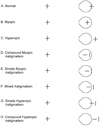Development and treatment of astigmatism-related amblyopia
- PMID: 19430327
- PMCID: PMC2706277
- DOI: 10.1097/OPX.0b013e3181a6165f
Development and treatment of astigmatism-related amblyopia
Abstract
Blur induced by uncorrected astigmatism during early development can result in amblyopia, as evidenced by reduced best-corrected vision relative to normal, in measures of grating acuity, vernier acuity, contrast sensitivity across a range of spatial frequencies, recognition acuity, and stereoacuity. In addition, uncorrected astigmatism during early development can result in meridional amblyopia, or best-corrected visual deficits that are greater for, or are present only for, specific stimulus orientations. Astigmatism-related amblyopia can be successfully treated with optical correction in children as old as school age, but the amblyopia may not be completely eliminated with optical treatment alone, and the age at which optical treatment is most effective has yet to be determined. Future research on determining the period of susceptibility of the visual system to negative effects of uncorrected astigmatism and exploration of alternative or complimentary treatment methods, in addition to optical correction, are warranted.
Figures

References
-
- Blakemore C, Cooper GF. Development of the brain depends on the visual environment. Nature. 1970;228:477–478. - PubMed
-
- Hirsch HV, Spinelli DN. Visual experience modifies distribution of horizontally and vertically oriented receptive fields in cats. Science. 1970;168:869–871. - PubMed
-
- Freeman RD, Mitchell DE, Millodot M. A neural effect of partial visual deprivation in humans. Science. 1972;175:1384–1386. - PubMed
-
- Mitchell DE, Freeman RD, Millodot M, Haegerstrom G. Meridional amblyopia: evidence for modification of the human visual system by early visual experience. Vision Res. 1973;13:535–558. - PubMed
Publication types
MeSH terms
Grants and funding
LinkOut - more resources
Full Text Sources
Medical

